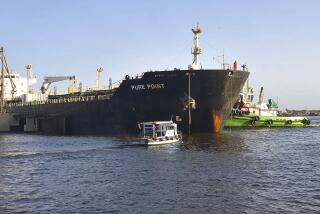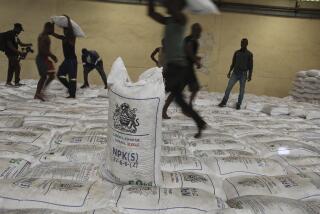Soviets to Solve Nicaragua’s Fuel Crisis : After Earlier Cut, Kremlin to Donate 100,000 Tons of Crude Oil
- Share via
MANAGUA, Nicaragua — The Soviet Union ended Nicaragua’s fuel crisis Monday by pledging to donate another 100,000 metric tons of crude oil this year.
The crisis, produced by growing demands of the contra war and an earlier cutback in Soviet commitments, could have left Nicaragua dry of oil by the end of this month, Western diplomats said.
President Daniel Ortega announced the move after meeting with an envoy of Soviet leader Mikhail S. Gorbachev. Ortega called it “an act of fraternal solidarity” and Soviet support for “decisions taken by Nicaragua on internal matters.”
This appeared to refer to a recent government decision to double prices and reduce rations for private consumption of gasoline. Diplomats said that both steps were a response to private warnings from Moscow that Nicaragua should use Soviet oil aid more efficiently.
Ortega told reporters that the Soviet donation will leave Nicaragua 55,000 tons short of what it initially planned to consume this year. But he said the new fuel restrictions, imposed a week ago, “will enable us to finish the year.”
Nicaragua has virtually no hard currency to pay for crude oil. The economy is plagued by inefficiency, a U.S. trade embargo and a war that consumes more than half its budget.
Venezuela and Mexico once supplied a large share of Nicaragua’s oil at concessionary rates but cut it off in the mid-1980s after Nicaragua accumulated unpayable debts. Since then, the Soviet Bloc has provided virtually all Nicaragua’s crude oil, charging next to nothing.
Total oil consumption here has risen from 600,000 tons in 1985 to the 750,000 tons targeted this year, with much of the increase going to fuel army trucks and helicopters in the war against U.S.-backed rebels.
A crisis developed in May when the Sandinista government announced that the Soviet Bloc was “facing limitations” and could send Nicaragua no more than 550,000 tons of oil this year.
Since then, Sandinista leaders have traveled in search of oil donations from Algeria, Iran, Iraq, Libya and Mexico, which produce their own, and from East Bloc nations that are supplied by the Soviets.
Figures announced by Ortega last month indicated that only Cuba had responded with a significant pledge. Cuba shipped 40,000 tons of its own Soviet-supplied oil to Nicaragua in August, on top of 60,000 tons supplied earlier this year.
Ortega said Monday that the new Soviet oil will bring Moscow’s total donation this year to 400,000 tons, more than half Nicaragua’s consumption. The rest comes from Cuba and Eastern Europe.
Nicaraguan and Soviet officials have never fully explained the Soviet oil squeeze. Some Sandinista leaders have suggested publicly that donor nations in general, the Soviets included, wanted their aid used more efficiently.
14 Cents a Gallon
Despite the price increase announced a week ago, gasoline remains heavily subsidized here at 14 U.S. cents per gallon for private consumers. Rationing was tightened to 17 gallons a week per car owner, from 19 gallons.
“At least it was a signal to the Soviets that Nicaragua is taking its oil problem seriously,” said a Western European diplomat.
Western diplomats and economists speculated the Soviet aid limitation may have also nudged Ortega into the peace agreement that he and four other Central American presidents signed Aug. 7. Among other things, it calls for a cease-fire in the contra war by Nov. 7, in exchange for steps by the Sandinistas to make Nicaragua more democratic.
In a related development Monday, Ortega said he plans to be in Moscow celebrating the 70th anniversary of the Bolshevik Revolution on Nov. 7, the day the peace accord is supposed to take effect.
More to Read
Sign up for Essential California
The most important California stories and recommendations in your inbox every morning.
You may occasionally receive promotional content from the Los Angeles Times.













